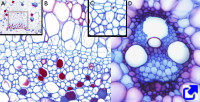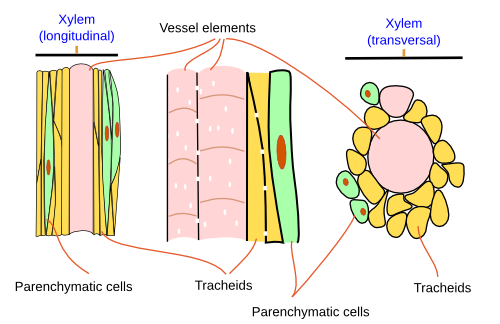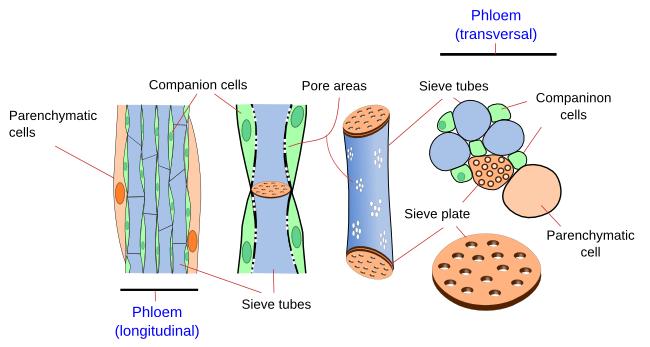Vascular plants have specialized tissues for transporting water with both dissolved inorganic and organic substances. These tissues are the xylem and phloem. Plants need vascular tissues to grow because they distribute water and organic and inorganic substances to feed the cells. These tissues also have a mechanical role in supporting the aerial parts and giving consistency to the underground organs, acting as a skeleton. Another function of vascular tissues is to facilitate communication between plant organs by carrying significant molecules, such as phytohormones.
1. Xylem
Xylem is responsible for transporting and distributing water and dissolved mineral salts, which mainly come from the roots, to the plant's body. It also carries some organic and signaling molecules. Furthermore, it is the main tissue for the mechanical support of plants, particularly in those with secondary growth. The wood is largely made up of xylem.
Xylem consists of four cell types: a) vessel elements and b) tracheids are the conducting cells, or tracheary elements; c) parenchyma cells work as storing and communication cells; and d) sclerenchyma and sclereids are supporting cells.

Tracheary elements (a and b) are cells containing lignin in their thick and hard secondary cell walls. The cytoplasmic content of these cells is lost during differentiation. The secondary cell wall of the tracheary cells forms thickenings that can be annular, helical, reticulated, or dotted structures.
Vessel elements (a) are cells with a larger diameter and more flat ends than tracheids. They are connected longitudinally to one another to form long tubes, also known as vessels. Vessel elements are the main conducting cells of the xylem of angiosperms (Figure 1).

Tracheids (b) are the second conducting cell type of angiosperms. They are the only tracheary element in gymnosperms. Tracheids are elongated, fusiform, thin cells. Their capacity for water conduction is lower than vessel elements due to their thicker cell walls and smaller inner volume.
Parenchyma cells (c) are organized in the conducting tissues in two ways: radially or axially. Radial parenchyma cells form rows, or rays, perpendicular to the surface of the organ, while axial parenchyma cells form groups, or rows, arranged longitudinally in the xylem. Multiple functions can be performed by parenchyma cells, including storing carbohydrates (starch), water, or nitrogen, and facilitating communication between xylem and phloem.
Sclerenchyma fibers and sclereids (d) provide support and protection for the tissues and organs of the plant.
The primary xylem is the first type of xylem developed during the formation of a plant organ. The protoxylem is developed from the procambium meristem during the organ growth, matures completely, and disappears later due to the compression of mechanical forces that are produced by the growth of the organ. The secondary wall of conducting cells of the protoxylem (vessel elements and tracheids) initially shows annular thickenings that later become helical. The metaxylem appears after the protoxylem, when the organ enlarges, and matures once the growth begins to slow. It also arises from the procambium. Metaxylem cells show larger diameters than those of the protoxylem, and the cell walls of the conducting cells have reticulated thickenings first and perforated thickenings later. The metaxylem is the mature xylem in those organs that don't go through secondary growth.

The secondary xylem is produced by the vascular cambium meristem in those organs with secondary growth. It is the mature conducting tissue in plants that shows secondary growth.
2. Phloem
The phloem, also known as sieve tissue or bast, is a conducting tissue that consists of living cells.v Its main role is transporting and distributing organic molecules synthesized by photosynthesis or mobilized from storing tissues, as well as signaling molecules like hormones.
Phloem is made up of more cell types than xylem. There are conducting and non-conducting cells. Conducting cells are the sieve tubes (a) and sieve cells (b). Both cell types are living cells without a nucleus, and their primary cell wall is thickened with callose deposits. Nonconducting cells are parenchyma cells that include the abundant companion cells (c). There are also supporting cells (d) associated with the phloem, such as sclerenchyma fibers and sclereids.
Sieve tubes (a) are the typical conducting cells of angiosperms. They are lined up into longitudinal rows and communicate with each other through sieve plates located at both ends (transverse) of each cell (Figure 2).

Sieve cells (b) are long cells with pointed ends. They are the only phloem-conducting cell of angiosperms and pteridophytes. Parenchyma cells (c) maintain the metabolism of sieve cells and store nutrients transported by the phloem itself. Sclerenchyma fibers and sclereids (d) are also found in the phloem with supporting and protection roles.
The primary phloem is the first phloem to be functional in developing organs. The first type of primary phloem to appear is the protophloem, which is later replaced by the metaphloem. Both the protophloem and metaphloem are derived from the procambium meristem. Metaphloem replaces protophloem during development, usually when the organ stops growing. The metaphloem contains sieve tubes and sieve cells that are thicker and longer than the protophloem; it always contains companion cells, and the sieve tubes show sieve plates. Metaphloem is the functional conducting tissue in plants with primary growth.
The secondary phloem arises from the vascular cambium meristem in plants with secondary growth. The conducting cells are well-developed, as are the companion cells, and both axial and radial parenchyma are present. Unlike xylem, secondary phloem cells do not synthesize secondary cell walls, and therefore they are living cells.
-
Bibliography ↷
-
Lalonde S, Francesch VR, Frommer WB. 2001. Commpanion cells. In: eLS. John Wiley & Sons Ltd, Chichester. http://www.els.net DOI: 10.1038/npg.els.0002087.
Furuta KM, Hellmann E, Helariutta Y. 2014. Molecular control of cell specification and cell differentiation during procambial development. Annual review of plant biology. 65: 607-638.
Spicer R. 2014. Symplasmic network in secondary vascular tissues: parenchyma distribution and activity supporting long-distant transport. Journal of experimental botany. 65: 1829-1848
.
-
 Support
Support